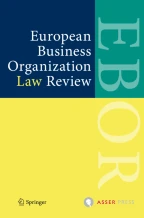The New Danish Companies Act of 2009

In EBOR 10(1) (2009, pp. 73–95), the Green Paper on a new Danish Companies Act was described in some detail. The Act has now been passed mostly as proposed in the Green Paper, except for some issues in respect of capital maintenance and the transfer of the registered seat of a company. Against this background, the main features of the new Act are explored and the minor differences from the original proposal are explained. It is concluded that although the new Act is now at the forefront of European company law and is especially well-suited to the needs of foreign enterprises and investors, reform is still necessary on a European level.
This is a preview of subscription content, log in via an institution to check access.
Access this article
Subscribe and save
Springer+ Basic
€32.70 /Month
- Get 10 units per month
- Download Article/Chapter or eBook
- 1 Unit = 1 Article or 1 Chapter
- Cancel anytime
Buy Now
Price includes VAT (France)
Instant access to the full article PDF.
Rent this article via DeepDyve
Similar content being viewed by others

Bankruptcy and Business Consolidation in Greece: An Exploratory Approach
Chapter © 2022

The Suitability of Belgian Law to B Corp
Chapter © 2023

REITs in Australia: Moving forward from the GFC
Chapter © 2013
References
- Act No. 470 of 12 June 2009 on Public and Private Limited Companies (Companies Act) [in Danish: Selskabsloven]. Bill L 170 (session 2008/09) with the annexed comments, which in Nordic jurisprudence are relied upon when construing the final act, as well as the final Act itself are available in Danish at the home page of the Danish Parliament: http://www.folketinget.dk. For a direct link to the Act, see the Retsinformation database: http://www.retsinformation.dk/Forms/R0710.aspx?id=125470 (visited on 7 July 2009). The Act will enter into force on an as yet unspecified date, probably at the end of 2009, and will be available at the home page of the Danish Commerce and Companies Agency: http://www.eogs.dk, which usually also provides translations of main acts into English.
- Green Paper No. 1498/2008. The report is available in Danish as apdf file at the home page of the Danish Ministry for Economic and Business Affairs: http://www.eogs.dk/graphics/_ny%20eogs/Love%20og%20Regler/Selskaber/Aktieselskaber/572381_Bet%E6nkning%201498.pdf (last visited on 7 July 2009).
- Cf. J. Lau Hansen, ‘The Danish Green Paper on Company Law Reform’, 10 European Business Organization Law Review (2009) p. 73.
- Directive 2007/36/EC of the European Parliament and of the Council of 11 July 2007 on the exercise of certain rights of shareholders in listed companies.
- On these, see Lau Hansen, supra n. 3, at notes 2 and 3.
- On the proposal for an SPE, ibid., at note 17. Contrary to the SE Company, the formation of an SPE does not include a cross-border element and, as such, the SPE will serve as a direct alternative to the formation of a national private company such as the Danish ApS. Whether the Member States are in fact ready to introduce a real alternative to their national forms of private companies or whether they will prefer to seriously impair its viability, as was done with the proposal for an SE statute, will become apparent when the Commission’s proposal is negotiated.
- The statutory minimum for public companies was kept at DKK 500,000 (EUR 67,149.25) as suggested by the Committee.
- A public investigator was appointed to examine the need for a statutory minimum share capital in private companies. His report was published as a Swedish Green Paper (SOU 2008:49). The Swedish Companies Act has not yet been amended in this respect. The investigator was also called upon to examine whether a new act should be drawn up especially for small and mediumsized enterprises. As was the conclusion of the Danish Committee, the Swedish investigator rejected this possibility, opting instead to provide the necessary flexibility in the existing Companies Act in respect of private companies.
- On the case law on nationality of companies, see Lau Hansen, supra n. 3, at note 10.
- Companies formed according to Regulation (EC) 2001/2157 on the Statute for a European Company (SE). An SE company may move its registered seat from one Member State to another; however, protection of any arrangements regarding the involvement of employees is provided by Directive 2001/86/EC.
- Directive 2005/56/EC of the European Parliament and of the Council of 26 October 2005 on cross-border mergers of limited liability companies.
- See the proposal for an act on international company law which would offer a similar possibility of transferring the registered seat and which was expected to be adopted in the first half of 2008 (Gesetz zum Internationalen Privatrecht der Gesellschaften, Vereine und juristischen Personen), presented by the Federal Ministry of Justice on 7 January 2008. On 18 November 2008, in answer to a question raised by a German MP, the promoters of the proposal explained that the proposal was more difficult than envisaged and its possible adoption would be postponed (Drucksache 16/11004, Deutscher Bundestag, 16. Wahlperiode).
- Directive 2003/6/EC of the European Parliament and of the Council of 28 January 2003 on insider dealing and market manipulation (market abuse).
Author information
Authors and Affiliations
- University of Copenhagen Law Faculty, Denmark Jesper Lau Hansen Dr. Jur. & LL.M. ( Professor of Financial Market Law, head of the FOCOFIMA research centre )
- Jesper Lau Hansen Dr. Jur. & LL.M.

